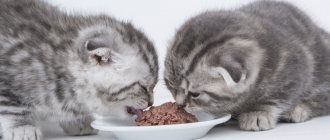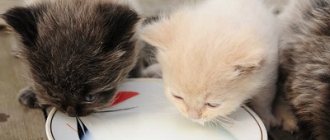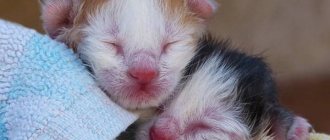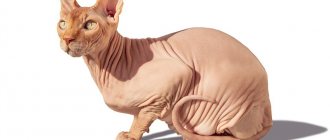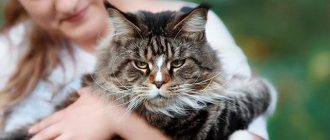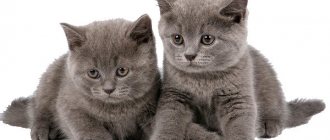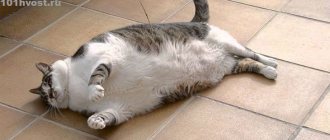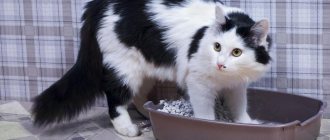It is advisable to carefully monitor your cat's weight at an early age. During this period, the kitten's weight allows us to evaluate the process of its development. Non-compliance with monthly norms may indicate malnutrition, illness and other abnormalities. Lack of weight gain is an alarming sign, so in this case you should immediately contact your veterinarian. It should be remembered that in the first weeks of life the pet is very vulnerable and the occurrence of any violations requires an urgent response.
Kitten weight by month: table
Weight depends on many factors, which include breed, gender, size of parents, individual characteristics, etc. At birth, a kitten can weigh from 80 to 150 g. For example, Maine Coons, on average, give birth to 130-gram kittens, while British cats – 100 grams, and outbred cats weigh about 90 g at birth.
The table below shows averages of how much animals weigh depending on age and breed:
| Age | Maine Coon | British cat | Sphinx | Outbred |
| 1 Week | 180-250 g | 110-230 g | 100-220 g | 100-250 g |
| 2 week | 280-350 g | 150-300 g | 130-300 g | 150-300 g |
| 3 week | 420-570 g | 210-500 g | 200-430 g | 200-500 g |
| 1 month | 560-730 g | 250-650 g | 230-590 g | 250-650 g |
| 2 months | 1.1-1.5 kg | 450-900g | 420-800 g | 400-1kg |
| 3 months | 1.7-2.2 kg | 1-2.5 kg | 900-2 kg | 1-2 kg |
| 4 months | 2.7-3.7 kg | 1.7-3.5 kg | 1.3-2.7 kg | 1.5-2.5 kg |
| 5 months | 2.9-5.3 kg | 2.2-4 kg | 2.1-3.9 kg | 2-3 kg |
| 6 months | 3.2-6 kg | 2.3-4.5 kg | 2.2-4.3 kg | 2.5-4 kg |
| 7 months | 3.5-6.5 kg | 2.4-5 kg | 2.3-4.6 kg | 2.5-4.5 kg |
| 8 months | 3.8-6.7 kg | 2.5-5.5 kg | 2.4-4.9 kg | 2.5-5 kg |
| 9 months | 4.1-7 kg | 2.5-5.9 kg | 2.5-5.3 kg | 2.5-5.5 kg |
| 10 months | 4.3-7.7 kg | 2.6-6.4 kg | 2.6-5.8 kg | 2.6-6 kg |
| 11 months | 4.4 -8 kg | 2.7-6.8 kg | 2.7-6.4 kg | 2.8-6.5 kg |
| 1 year | 4.6-9 kg | 3-7 kg | 3-7 kg | 3-7 kg |
Weight control and diet for cats: what do we have?
The well-being of any cat, both short and long term, depends on maintaining a healthy weight. This not only affects the overall quality of life, but also helps reduce the risk of disease and increase life expectancy.
Unfortunately, recent studies have shown that about 50% of pets are overweight or obese. Such high rates are largely due to the fact that pets may experience a lack of physical activity. In addition, owners do not always take into account the special dietary requirements at different stages of a cat's life to maintain its normal weight. Just like humans, your furry friend's nutritional needs vary depending on lifestyle
In this situation, it is important to maintain a balance.
The following factors may also contribute to excess weight gain in cats:
- floor;
- sterilization;
- accompanying illnesses;
- age;
- lack of physical activity.
It is now known that selecting an animal’s diet requires an individual approach that takes into account the lifestyle and age of a particular pet.
Weight gain in the first month
The first four weeks of life are characterized by the most intensive growth. The weight of a kitten in the 1st month can increase up to 15 g every day. At the end of this period, it can be two or even three times greater than at birth. Such intensive growth is noticeable to the naked eye. If at this age there is a slight gain in body weight, then you need to seek help from a veterinarian to diagnose and correct the situation.
In the first month, the kitten needs intensive care and good nutrition. The optimal diet is provided by mother's breast milk. However, a cat cannot always feed its offspring for various reasons. In this case, the role of “mother” falls on the pet owner. The best substitute for mother's milk are special industrial mixtures, the composition of which duplicates the natural components as much as possible. The dosage and frequency of feeding depend on the age and size of the animal. So, in the first week he should be fed about 4 ml every 2-4 hours, and in the second week - every 4-6 hours, 5 ml. With proper nutrition, by the end of the fourth week he will weigh 300-400 g, his first teeth will grow and he can already be given additional food.
In addition to rapid growth, signs of your pet’s health in the first four weeks of life will include:
- ability to stand on one’s paws (way and not confidently);
- active behavior;
- healthy sleep;
- regular bowel movements.
Why monitor the development of newborn kittens?
Between birth and one month, kittens quickly gain weight. Regardless of the breed: Scottish, Thai, Fold, British, Bengal, Siberian or mongrel cats usually grow the same. Newborn babies weigh approximately 100 grams, grow day by day, and by a month can reach up to 500 grams.
Kittens gain 10-15 grams of weight every day.
If the cat doesn’t get it, there are a number of reasons for this:
- Congenital diseases.
- A large number of kittens in the litter.
- Poor maternal diet.
If the pet's weight is below normal, the pet may not be getting enough nutrition.
In the first case, the cat itself is lethargic, sleeps a lot, and not with all the kittens, but separately. In other cases, it is necessary to increase the daily diet for the mother cat.
For a nursing cat, nutrition increases by 25-30%.
Weekly weighing of kittens will allow you to find out whether the baby is developing normally and whether he has enough nutrition.
Kitten weight at 2-3 months
During this period, intensive weight gain continues, although not as active as before. For every 30 days, the kitten almost doubles in size, and by the end of the 3rd month it will weigh approximately 1.5-2 kg. He can already eat soft food, so you should diversify his diet and don’t forget about water. Stores sell special food for kittens, which may come in the form of a pate or soft pieces in a sauce. Since the small pet is already actively exploring the territory, it is necessary to limit its access to adult food, which will be too tough for it.
Possible reasons why a kitten’s weight does not correspond to age standards
The main reasons for a kitten’s weight not meeting age standards are:
- Lack of nutrition. The first months of life, kittens may suffer from a lack of milk. This may be due to an unbalanced diet of the cat or a large number of brothers and sisters of the baby.
- Unbalanced regime and diet of the kitten. In particularly advanced cases, the baby’s development stops.
- Deviations associated with genetics or heredity. This applies to a greater extent to purebred kittens. It is necessary to find out what diseases can be passed on to the baby from mom and dad. If a kitten is suffering from underweight, you should check with the breeder what parameters its parents had at the same age.
- Infectious diseases and viruses. Diseases can affect the kitten’s gastrointestinal tract, which affects the absorption of food. The absorption of beneficial elements deteriorates, so the baby may not gain weight.
- Worms. At any age, helminthic infestations are dangerous for an animal, and even more so during the formation of a young organism. If a kitten is infected with worms, it will not grow well.
In the last three cases, the owner must immediately contact a veterinarian to prevent possible death of the animal or the development of diseases and transition to chronic forms.
In order for the kitten to develop normally, it is necessary to consult a specialist and follow feeding recommendations. In addition, if some deviations in the baby’s development are noticed, immediate action must be taken. The delicate body of a kitten does not yet have the immunity of an adult animal, and many infections can seriously harm it.
The norm is 4-5 months
At this age, the average weight of a kitten is 1.5-3 kg. The period of intensive growth has ended, but the pet still continues to gain weight. At the end of the 5th month, males can reach 4 kg.
Your pet still needs to eat baby food frequently. The number of feedings is up to 5 times. Diets should be chosen with the maximum protein content, which is necessary for the normal development of the growing predator’s body. Industrially produced food is marked with the appropriate inscription “For kittens”. However, it is necessary to carefully study the composition in order to choose a quality nutrition.
How much does a cat weigh and developmental features?
1 month
An average monthly cat weighs 400-500 grams. He actively begins to explore the world, crawls out of the box on his own, and gets acquainted with adult food. At this age they love to play and sleep often, but little.
At 1.5, babies' eye color changes. They begin to look for the tray on their own and visit it regularly. This is a good age to look for new owners.
2 months
Pet weight 450-900 g.
At this age, kittens have heightened curiosity - they explore the world around them, try everything with their teeth and paws.
Playful, affectionate. Their outlines take on those of an adult cat.
Two-month-old kittens are already accustomed to combing, washing and trimming their nails.
Lack of exercise in cats can lead to excess weight
3 months
The weight of the cat is 1000-1500 g.
He is already playful and affectionate, accustomed to his owner and affection. Responds to a nickname, independently finds a tray, bowls of food and water.
Three-month-old kittens have fully formed eye color, as well as baby teeth.
By this age, boys surpass their sisters in size.
4 months
Hang 1700-2400 gr.
Kittens become less playful, although they like to chase toys around the house. They become like adult cats: they sleep more, go to the bowl less often, and become calm and affectionate.
The replacement of baby teeth with permanent ones begins.
5 months
They hang 2200-2900 gr.
Kittens are slightly smaller than an adult cat. At this age they are transferred to three meals a day.
The presence of any irritants in the house can reduce appetite and lead to lack of food intake.
Half a year
Hang 2300-3600 gr.
Six-month-old cats have finished changing their teeth.
They are proportionally harmonious and graceful in their movements. Hunting instincts are developed.
At 6 months, kittens end their active growth phase and gain significantly less weight.
7 months
Hangs 2400-3900 g.
Males and cats begin their first molt and puberty. If a girl and a boy live together, then they begin to be interested in each other, and the males court the females.
Now the pet needs regular brushing so that the fur it licks off does not cause stomach upset.
8 months
Hangs 2500-4100 g.
At this age, it is recommended to spay and neuter cats if they are not planned for breeding.
The period of active growth and weight gain plays a special role in the development of the baby.
9 months
2500-4300 gr.
At this age, kittens look like adult cats and gain almost no weight.
10 months
Hangs 2500-4400 g.
At this age, cats begin their first heat.
It is not recommended to breed cats before 12 months of age to avoid birth complications.
From the age of ten months, kittens participate in exhibitions in adult categories.
11 months
Hangs 2500-4500 g.
A fully formed adult animal that has stopped growing. Now you can switch your pet to adult food.
Year
Hangs 2500-4600 g.
Already an adult animal that eats food for adult animals is able to participate in mating and exhibitions.
Some breeds are fully mature by age two, such as Maine Coons.
Cat weight at 8-12 months
By the time a cat is one year old, it is considered an adult. Its dimensions practically do not change, and on average reach 4-6 kg depending on the breed and gender. By the age of one year, it is necessary to reduce meals to two times a day and monitor its balance. It is important to feed animals with good food, in which the protein level is more than 30% (if we talk about industrially produced feed). High-quality balanced nutrition will be the key to the normal functioning of the cat’s body and is the prevention of obesity.
Weight value
Determining the weight of a pet kitten is an excellent way to assess its growth and development. If weight is gained slowly, this indicates health problems. Also, a nursing cat may have problems with well-being. The second reason for poor recruitment is a lack of nutrients (for example, many cubs were born in the litter).
Kittens are characterized by rapid growth, as in natural conditions they leave their mother at the age of 12–16 weeks. Therefore, at the beginning of their lives, they should eat a balanced and high-calorie diet. Every week the cub should gain 50–100 g. If the animal gains less, it must be shown to a veterinarian. But there are cases when a pet experiences a temporary stabilization of this indicator. Then the set resumes and proceeds at an accelerated pace.
For each breed of cat there is a special table that indicates the normal weight of the animal depending on its age. This is important to know, since the norm is directly dependent on two indicators - age and breed.
Therefore, you can find out how much a kitten of a particular breed should weigh without any problems. Do not forget that this indicator is seriously influenced by a nutritious, balanced and rational diet.
Weighing procedure
To find out how much a kitten weighs, you can use a kitchen scale in the first months. A small pet will fit well in a bowl or bowl. In the future, you can use a canter scale by placing the animal in a bag with two handles or a basket. It is necessary to subtract the weight of the bag itself from the result obtained in order to obtain reliable data. Using the subtraction method, you can also weigh your pet using floor scales, which the owner first stands on himself, and then with the pet.
Weighing an animal may be required in the following cases:
- artificial feeding;
- pathologies at birth;
- suspicion of developing the disease;
- development control.
Why does a kitten weigh less than normal and what to do about it?
There is no need to panic if the baby’s weight is slightly below normal, but he is cheerful, active and does not have any alarming symptoms such as vomiting, diarrhea, excessive salivation, dull hair, etc.
If there is significant underweight, when the kitten's ribs and pelvic bones are visible, you should immediately contact a veterinarian. Frequent reasons for such deviation:
- Starvation. A hungry kitten looks exhausted, lethargic, has bloating and diarrhea, and in severe cases, symptoms of rickets and anemia. Underweight may be due to a lack of mother's milk or an unbalanced diet when the kitten has already been weaned. It is necessary to increase the volume of mother's portions by 2–3 times during lactation. If this measure does not give the desired result, you need to supplement the baby with formula milk.
- Taste of milk. Sometimes a kitten refuses mother's milk because of its bitter taste, which appears due to the cat's postpartum illness (for example, mastitis or acute metritis). The baby looks exhausted, meows pitifully, and has bloating, diarrhea and redness of the anus. In order not to provoke blood poisoning, the baby is transferred to artificial feeding and detoxification therapy is carried out.
- Parasitic disease. A sick pet, despite a good appetite, does not gain weight. The baby has a tight belly, dull fur, sometimes constipation or diarrhea, traces of blood, mucus and parasite eggs are visible in the stool. The developmental delay is due to exhaustion: the incoming nutrients are spent not on the growth of the kitten, but on maintaining the vital activity of helminths. Worm infestation is especially dangerous at this age and can be fatal, so you should immediately contact a veterinarian.
- Diseases of the gastrointestinal tract. In this case, the kitten even loses body weight, because due to the disease, the mucous membrane of the digestive tract is affected, and nutrients are no longer absorbed by the body. A sick baby experiences symptoms such as vomiting, fever, excessive salivation, changes in stool, etc. A complete cure requires complex therapy, including not only treatment of the underlying disease, but also vitamin therapy and special nutrition.
Stress
Early separation from the mother, moving, increased attention from family members, loud noises, etc.
– all this causes discomfort to the baby, forcing him to refuse food and seek shelter
During this period, it is important not to impose games on your pet and give him the opportunity to adapt to new conditions.
Making your own kitten formulas
You can prepare milk formulas for small kittens aged 2 weeks to a month yourself using simple recipes:
- Tailing's mixture is nutritious and will be especially useful for exhausted, weakened, and poorly gaining weight babies. To prepare the mixture, add 5 g of milk powder, cat vitamins (1 g), and glucose (4 g) to 25 g of homemade milk. All ingredients are thoroughly mixed until smooth, without lumps, and heated over low heat to +38°C. The finished mixture is cooled to room temperature and used to feed artificial kittens through a pacifier or pipette.
- Scott's formula is a complete nutrition for kittens that can even replace mother's milk. To prepare this recipe, you need to combine the ingredients in one container: cow's milk (50 g), yeast (3 g), milk powder (15 g), sugar (5 g), sunflower oil (1 g), whipped egg white (50 g) , egg yolk (1). The mixture is whipped until smooth and heated to +37°C with constant stirring. The finished composition is poured into a bottle and cooled to room temperature. The mixture can be stored in the refrigerator, but no more than 1 day.
Possible ways to feed kittens
At the age of 2 weeks, it is extremely important to pay special attention to the correct algorithm for feeding kittens:
- Place . The baby should be placed on his knees, with a disposable diaper or polyethylene placed under his abdomen, and his head should be slightly raised. Most owners note that the most convenient place for feeding is a small box with sides. The baby needs to be placed on the bottom of the box so that his front paws rest against the side, lift his head by the scruff of the neck and start eating.
- Inventory . For feeding you need to use pipettes, disposable syringes and bottles. In this way, nutrition will enter the baby’s body drop by drop, as evenly and safely as possible. If the kitten's sucking reflex is poorly developed, it is better to replace the bottle with a nipple with a syringe or pipette. Using a syringe requires taking a number of precautions. Firstly, it is best to equip the syringe with a rubber tip, which reduces the likelihood of traumatic injury. It is important to teach the kitten to lick the mixture from the syringe, since it is impossible to completely introduce it into the oral cavity of small pets due to increased trauma to the gums and mucous membranes of the oral cavity.
- Head position . It is important that when feeding, the kitten's head is in a straight position and its paws are down. It is advisable for the baby to suck the milk himself. Therefore, you need to try not to pour food into the kitten’s mouth.
- Feeding rules . You need to feed slowly, without haste or fuss, so that the kittens do not choke.
Where would we be without vitamins?
When artificially feeding, the kittens' diet must include specialized supplements and vitamin complexes to compensate for the deficiency of those substances that babies receive from mother's milk. A veterinarian will help you choose the right drug and determine the dosage.
Special supplements that are well suited for 2-week-old babies include:
- Trivit (1 drop each);
- glucose (1 to 2 g during feeding);
- bone and meat flour (an excellent source of calcium for bones, tooth enamel and joints and ligaments of children);
- fish oil (1 drop once a week) – perfectly enriches the body with vitamins D;
- vitamin A;
- vitamin E;
- vitamin D;
- a preparation containing B vitamins.
It is important to take into account the fact that ready-made cat milk substitutes and formulas already contain a certain amount of vitamins, and most supplements are designed for kittens one month and older.
An excess of substances can be just as dangerous to the health of children as their deficiency, so it is necessary to correctly calculate the optimal dosage of each drug.
Development in the third week
During the third week, all kittens' eyes open. However, vision is not yet good enough to navigate in space. It is necessary to monitor all physiological changes to ensure that the development of kittens corresponds to their age and to promptly eliminate irritating factors that may interfere with normal growth.
The main stages of development of newborn kittens take place in the first three weeks, as their body is actively growing and all the organs of smell and touch are formed. It is at the age of three weeks that kittens first try to stand on their paws and their teeth appear.
© shutterstock
The formation of the jaw will take up to two months. From the third week, you can safely accustom the baby to your hands, constantly play with him and stroke him, and in order to let the pet know that the owner is also one of his friends, in addition to the other kittens and the mother.
How to determine a cat's normal weight
You can assess the condition of your pet visually by looking at the animal from different angles. Thus, assessing the condition when looking in profile will allow you to assess the condition of the abdomen and limbs, and looking from above will help you determine the waist and evaluate the lumbar region.
For a more accurate assessment, it would be a good idea to palpate your pet’s body. Walk your hands along the ribs without pressing too hard. If the bones stick out with a slight touch, then - exhaustion, but if you need to make an effort and apply pressure to palpate - obesity.
Then you can move on to the waist. This area is sensitive, so you should handle your pet carefully. By running your palms along the waist to the pelvis, you can feel the almost hourglass shape. In obese cats, the waist cannot be felt.
You should pay attention to the stomach. A little softness on your stomach is completely normal. But if the abdominal fold hangs down and sways in different directions when the cat moves, then this is a sign of obesity.
But if the abdominal fold hangs down and sways in different directions when the cat moves, then this is a sign of obesity.
Flaw
Very thin hairless and short-haired individuals with low weight have visible ribs, very pronounced pelvic bones and a spine with minimal muscle mass, with a minimal layer of fat or no fat at all. The ribs can be easily felt. The stomach is strongly tucked. The neck is thin. In such a situation, the help of a veterinarian is necessary; perhaps the animal has health problems, for example, a helminthic infestation.
In thin individuals, the ribs are easily noticeable, muscle mass and a layer of fat are minimal. The vertebrae are clearly visible, the waist is visible. The abdominal fold is weakly defined with minimal fat.
Ideal
At ideal weight, cats have a well-proportioned body with a noticeable waist after the ribs. The waist is clearly visible when viewed from above (the shape of the torso resembles an hourglass shape). The ribs can be felt, but the fat layer is minimal. When viewed from the side, the stomach is tucked in. But breed characteristics should be taken into account. After all, representatives of some breeds are built more elegantly and refinedly, while others are naturally stocky and heavy; in such animals the presence of an abdominal fold can be considered normal in accordance with the Standard.
Excess
In slightly overweight pets, ribs covered with a small amount of fat may be palpable. The waist is little noticeable. At a more advanced stage of obesity, the waist is indistinguishable, the ribs are hidden under a layer of fat and cannot be felt, the stomach is rounded, and there is a clear presence of fatty tissue in the abdominal area. Fat deposits are present on the face and on the limbs, lower back, and even on the tail. If you are obese, you need the help of a veterinarian who will give recommendations on proper nutrition and exercise regimen that will help you lose weight. With self-control, you should act gradually; you should not allow sudden weight loss. Changes are made to the diet, namely reducing the caloric content of food or selecting appropriate dry food for cats suffering from or predisposed to obesity.
Excess weight can lead to a number of health problems, so it is important to control your pet’s diet and prevent overeating. Of course, you can pamper your pet, but within reason, because what could be more important than the health of a cat, whose life expectancy is already short. Returning to the problem of obesity, it is worth mentioning the possible problems it leads to: diabetes mellitus, heart disease, liver dysfunction, joint diseases
Returning to the problem of obesity, we should mention the possible problems it leads to: diabetes, heart disease, liver dysfunction, joint diseases.

